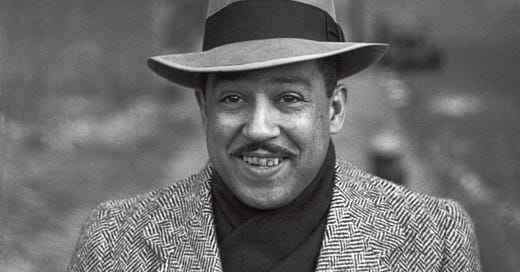Black Film Archive is a living register of Black films from 1915 - 1979 currently streaming. This Substack is its blog. Thank you for being here!
In daytime hours,
guided by instincts
that never sleep,
the faintest signals
come to me
over vast spaces
of etiquette
and restraint.
– Essex Hemphill, "Better Days”
In the lyrical “Looking for Langston” (1989)1, director Isaac Julien constructs a mosaic of the inner world of Langston Hughes (1902-1967) and his Harlem Renaissance compadres using archival riches, music, correspondence, and published work. In this dream-like cinematic tone poem, a portrait of unexplored, unmet, unexplained desires and their polar dance around the viewer’s imaginations while words from queer male writers visually and sonically float. This cinematic meditation is a profound dialogue between Langston’s perceived (and documented)2 queerness and its relationship to memory and the film’s present. “Looking for Langston” displays queerness as both dynamic and the energetic force of the film and — as Isaac Julien’s masterwork suggests — life. Like most other mentions of Langston’s queerness, the Hughes estate has contested the film. But the dynamism of queerness it provides is a good structure to understand how a distinctly Black queer culture shaped the Harlem Renaissance (1920 - 1935) along with Black cultural and cinematic futures.
Langston Hughes — born at the turn of the 20th century in Joplin, Missouri, and raised in Topeka, Kansas — is best remembered for his jazz-inflected poetic imagery of dreams, racial equality, poverty, and loneliness. In the 1930s, as the Harlem Renaissance heyday was sunsetting, Hughes became one of several well-connected and well-liked Black authors who looked towards screenwriting to make a living. The author decided that his “Rejuvenation through Joy”3 — a satirical short story centered on a Black man, passing for white, selling joy and blackness for his personal gain — should be his first cinematic work. After Paramount Studios passed, Hughes found work in co-writing RKO’s musical drama “Way Down South” (1939) with the prolific Black actor and screenwriter Clarence Muse. For the first time in his life, he could live only on his writing. Co-writing the music, story, and script, Hughes and Muse craft a stereotypical melodrama that centers white man as a “benevolent” and devoted enslaver after his father, equally “benevolent,” passed. In Hughes, we find a familiar story: A Black worker has ambitious, perhaps radical, dreams to uplift themselves in their vision but has to compromise with what the establishment offers. Hughes and Muse were also treated as if they were lucky to be employed, and their original vision suffered under the thumb of white studio executives.4 Considering the evident racist attitudes of the Hollywood studio system on and off the screen, it remains a miracle that this film was made. After “Way Down South” was released to financial success, Hughes — a deeply embarrassed one-time screenwriter — was accused of selling out by the progressives in his circle. Through a 1950s essay, Hughes reflects:
Hollywood is the bête noire. It produces America (and the world’s) most popular art, and is one of the great industries. It is a mighty educational force, as well as a powerful force for miseducation. Hollywood is cognizant of its powers. Yet, shamelessly and to all the world, Hollywood has since its inception spread in exaggerated form every ugly ridiculous stereotype of the deep South’s conception of Negro character.
In the archive, it is natural to search for whatever self we bring to it and occasionally see glimpses of our unique beauty. In “Looking for Langston,” Isaac Julien sees the beauty in Langston’s queerness and shares it with the world. Below, I’ve shared two of the queer films Black Film Archive has to offer.
Behind Every Good Man (1967)
“I’d like to live a happy life,” a Black trans woman declares in this hopeful, vital short cultural document allows her to narrate her own life, desires, and ambitions as she saunters around Los Angeles.
Norman. . . Is That You? (1976)
“Norman…Is That You?” remains one of the most puzzling films on Black Film Archive. A dated comedy, starring Redd Foxx and Pearl Bailey, the film works through a clutter of cliches after parents (Foxx and Bailey) discover their son is gay. Eventually reaching the conclusion that they love their son, the film is a noted inspiration for Cheryl Dunye’s “The Watermelon Woman.”5
P.S. - As of next week, Black Film Archive will be my full time work. I’m excited to be writing here more often and devote my time to the Archive ahead of its one year anniversary on August 26. (!) Thank you all for making this dream a reality for me.
Worth seeking out. Not currently streaming (and Black Film Archive is still focusing on films through 1979.)
Black American Cinema, 1993.
Interview Magazine interview with Cheryl Dunye.






What a lovely offering Maya, thank you. All best with your full time work on the archive coming up.
I love this archive and newsletter so much! Thank you, Maya and congrats on the opportunity to work on this full time! ✨